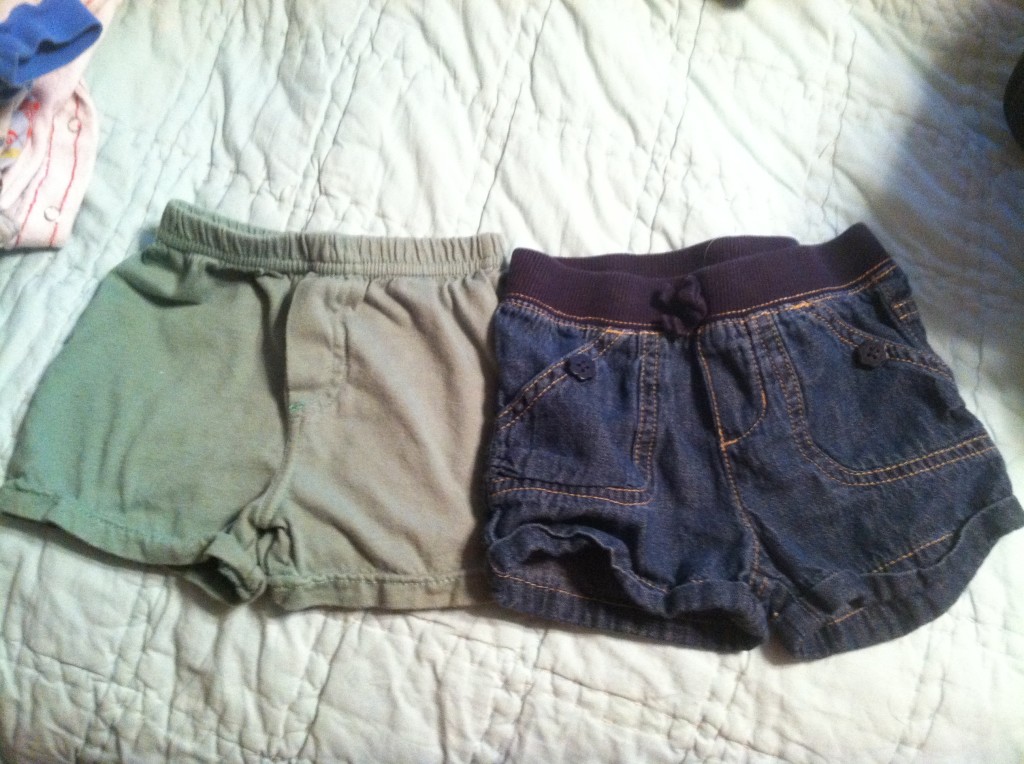Packing for 4 for any length of time can be quite an event. While I am quite practiced at it and each child has a bag and they even help me gather the necessary items, I have found the best approach to be to pack on a grid: types of clothes in a line for each kid.
And while I check and double check, invariably someone arrives without a swimsuit, underwear or seasonally appropriate shirts. I’ve accepted it as my lot in life .
So when I dug through 3 baskets full of clean clothes and couldn’t find a single pair of shorts for Baby M, frustration arose. Digging, digging. Aha! Yes. When he ends up without pants, it will be a surprise, not because nothing is clean.
Then I realized they weren’t his shorts. They belong to the (nearly) 3-year-old daughter.
I’ve realized that these shorts were, well, short. Most of them are. Frustratingly so. Both of my girls have more than a pair of shorts that don’t pass the fingertip rule.
My problem is a little bit the lack of modest options for my 3 – THREE – year old. But the other problem is the double standard. The clothes makers are cutting the same pattern for my 3-year-old girl as my 6-9 month old son. (In actuality, he’s a year old, but apparently quite the scrawny guy.)
The shorts I folded for my oldest boy when he was 3 were distinctly bigger than his infant sister’s. Why is this not the case for the girls in comparison to the infant brother?
Part of the solution is me – and you – the consumer. We buy it and therefore it continues. It’s a known economic fact that companies rarely continue product lines that sit on the shelf year after year. So solution #1 is to stop buying short shorts.
This incident is the tip of the iceberg when it comes to my internal struggle to talk about bodies and sexuality and standards, especially with my girls. (Note: I’m quite careful that the boys hear the same message, but they generally have to think very little about what they wear.) How do we explain differences, some that are anatomical and some that are socially-driven? Why do we expect certain things from boys and girls? Quite clearly, we’re different, only one of the genders can carry a baby on the inside. But how does that translate into how we look at our bodies and then dress them?
This morning H Boy asked if he could go to swimming lessons in just his trunks, without his sun shirt, and I agreed. So, of course, Miss M asked if she could go bottoms-only. I told her no and, as expected, she wanted to know why. It didn’t make sense in her head: boys boobies and girls boobies at this point look pretty much the same. Why is one person’s expected to be covered? (My response was that I wasn’t sure, but I thought it was related to girls being able to feed babies with their boobies. Which is not helpful because I think it’s completely appropriate to feed babies in plain view. I’m discrete when I nurse, but your discomfort with my breast is not a reflection of me or my hungry child, it’s an indication of your view of breasts.)
Teaching modesty is a struggle for me right now. I don’t believe short shorts are advantageous to anyone in our society and while I want my girls (and boys) to be free to express themselves through their fashion, I’m not sure short shorts express anything noble except to say “ASS”. Honestly. What else do short shorts say? Am I missing something? I don’t believe the girls choose the short shorts because they advertise their sexuality, but I do believe they wear them because they’re available. It’s what they know.
Oh, dear reader, we’re in for a journey on this one. Stay tuned.



